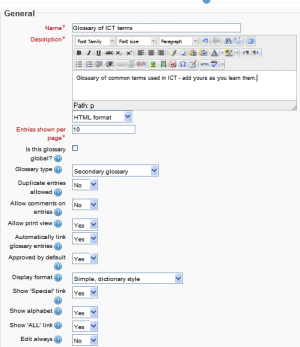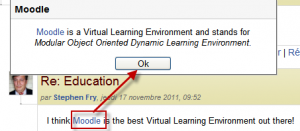Glossary settings: Różnice pomiędzy wersjami
Mary Cooch (dyskusja | edycje) mNie podano opisu zmian |
(DE-Link fixed) |
||
| Linia 197: | Linia 197: | ||
[[Category:Site administration]] | [[Category:Site administration]] | ||
[[de: | [[de:Glossar konfigurieren]] | ||
[[ja:用語集エントリを追加/編集する]] | [[ja:用語集エントリを追加/編集する]] | ||
Wersja z 15:02, 25 kwi 2012
Adding a glossary
To add a glossary:
- Click the "Turn editing on" button.
- Select Glossary from the "Add an activity" dropdown menu.
- On the Adding a new glossary page give your new glossary a descriptive name.
- Describe the purpose of the glossary, provide instructions or background information, links etc. in the Description area.
- Select the general and grade options and the common module settings (see below).
- Click the "Save changes" button at the bottom of the page.
Glossary administration settings
Entries shown per page
This sets the number of words and definitions that students will see when they view the glossary list. If you have a large number of automatically-linked entries you should set this number lower to prevent long loading times.
Is this glossary global?
Administrators can make a global glossary, with entries linking throughout the whole Moodle site. Any course may contain a global glossary, though the best practice is to place a global glossary on the site front page.
Glossary type
Here you can decide whether the glossary will be main or secondary. The glossary system allows you to export entries from any secondary glossary to the main one of the course. In order to do this, you should specify which glossary is the main one. You can only have one main glossary per course.
Duplicated entries allowed
This allows the entry of more than one definition for a given word.
Allow comments on entries
Students and teachers can leave comments on glossary definitions. The comments are available through a link at the bottom of the definition.
Allow print view
This provides a printer-friendly version link for students. (Teachers are always provided with a printer-friendly version link.)
Automatically link glossary entries
If the Glossary auto-linking filter is enabled by an administrator (see Filters for further details), then turning this on allows individual entries in this glossary to be automatically linked whenever the concept words and phrases appear throughout the rest of the same course. This includes forum postings, internal resources, week summaries and so on.
Note: Enabling linking for the glossary does not automatically turn on linking for each entry - linking needs to be set for each entry individually. If you do not want particular text to be linked (in a forum posting, say) then you should add <nolink> and </nolink> tags around the text. Note that category names are also linked.
This entry is case sensitive
This setting specifies whether matching exact upper and lower case is necessary when performing automatic linking to these entries. For example, if this is turned on, then a word like "html" in a forum posting will NOT be linked to a glossary entry called "HTML".
Match whole words only
If automatic linking is enabled, then turning this setting on will force only whole words to be linked. For example, a glossary entry named "construct" will not create a link inside the word "constructivism".
Approved by default
That allows the teacher to define what happens to new entries added by students. They can be automatically made available to everyone, otherwise the teacher will have to approve each one.
Display format
That specifies the way that each entry will be shown within the glossary. The default formats are:
- Simple, dictionary style - This looks like a conventional dictionary with separate entries. No authors are displayed and attachments are shown as links.
- Continuous without author - That shows the entries one after other without any kind of separation but the editing icons.
- Full with author - A forum-like display format showing author's data. Attachments are shown as links.
- Full without author - A forum-like display format that does not show author's data. Attachments are shown as links.
- Encyclopedia - Like 'Full with author' but attached images are shown inline.
- Entry list - This lists the concepts as links.
- FAQ - Useful for displaying lists of frequently asked questions. It automatically appends the words QUESTION and ANSWER in the concept and definition respectively.
The table below summarises the different display formats.
| Format | Entry | Author | Date | Definition | Images | Attachments |
|---|---|---|---|---|---|---|
| Entry list | x | - | - | x* | x* | link* |
| Simple Dictionary | x | - | - | x | x | link |
| Continuous | x | - | - | x | x | link |
| FAQ | x | - | x | x | x | link |
| Full without Author | x | - | x | x | x | link |
| Full with Author | x | x | x | x | x | link |
| Encyclopedia | x | x | x | x | x | x** |
* Will be shown in a pop-up window.
* * Attached images are shown inline.
RSS in Glossaries
If RSS feeds are enabled, you will see two additional fields under the glossary setup page:
RSS feed for this activity
This turns RSS on or off. When set to “None,” the RSS feed is disabled. When set to “Concepts with authors,” the RSS feed will send out the glossary entries with the name of the author. When set to “Concepts without authors,” the RSS feed sends out glossary entries without the name of the author.
Number of RSS recent articles
This number sets the number of entries that go out via RSS. If this number is set to 5, then the 5 most recent articles will be sent to subscribers. As new entries get added, the oldest entry gets replaced on the RSS feed. If your glossary gets a lot of posts every day, you will want to set this number high.
When RSS is enabled for your glossary, an orange RSS button appears on the main page (in the upper right-hand side). When a user clicks on the RSS button, they see the XML code displayed, needed by the news-reader. Once a user has the RSS news-feed link, adding it to a reader is simple and will then display Forum and Glossary aggregated information, along with other information they subscribe to.
Glossary permissions
Role permissions for the activity can be changed in Settings > Glossary administration > Permissions.
Site administration settings
The glossary module has additional settings which may be changed by an administrator in Settings > Site administration > Plugins > Activity modules > Glossary.
Glossary level default settings
- glossary_entbypage - Number of Glossary entries shown per page. Default is set to 10.
- glossary_dupentries - Whether or not the Glossary will allow duplicate entries. Default is set to "No".
- glossary_allowcomments - Whether or not the Glossary will accept user comments on its entries. Default is set to "No".
- glossary_linkbydefault - Whether or not a glossary should be automatically linked. Default is set to "Yes".
- glossary_defaultapproval - Whether or not the Glossary will define the approval status of an entry posted by a student. Default is set to "Yes".
- glossary_enablerssfeeds - Enabling of RSS feeds for all glossaries. Default is set to "No". Note: feeds will still need to be turned on manually in the settings for each glossary.
Entry level default settings
- glossary_linkentries - Whether or not glossary entries should be automatically linked. Default is set to "No".
- glossary_casesensitive - Whether or not an entry is case sensitive when linked. Default is set to "No".
- glossary_fullmatch - Whether or not an entry should match the case in the target text by default when linked. Default is set to "No".
Display Formats Setup
To hide or show any of these entries, simply click on the "eye" icon next to the entry. Clicking on the "writing hand" icon will take you to the settings page for that entry.

